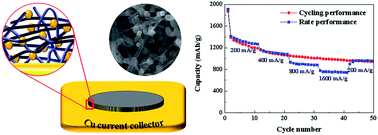A self-assembled Si/SWNT 3D-composite-nanonetwork as a high-performance lithium ion battery anode†
Abstract
In this work, we have prepared a 3D-composite-nanonetwork material consisting of a single walled carbon nanotube (SWNT) network and Si nanosphere embedded elements, through an electrostatic induced self-assembly process and the following film transfer technique. Negatively charged acid-functionalized SWNTs and positively charged surface-modified Si nanospheres composed a highly dispersed system, which was key to the fabrication of a self-assembled active material film. After transferring it to the Cu foil substrate by a novel film transfer technique, an integrated anode for lithium ion batteries (LIBs) was obtained without using binders or conductive additives, and exhibited excellent electrochemical performance. The continuous 3D conductive network consisting of SWNTs provided a rapid electronic transport pathway, which was able to counteract the conductivity decline caused by the formation of a solid electrolyte interface layer, thus ensuring a superior rate capability and cycling stability. This combined process of self-assembly and film transfer would provide a new idea for the design and preparation of LIB electrodes, especially those which are restricted by low conductivity and large volume change during cycling.


 Please wait while we load your content...
Please wait while we load your content...